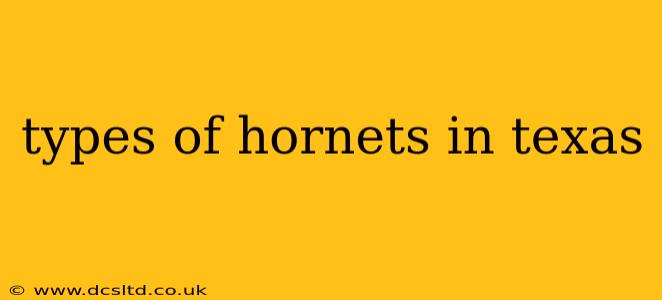Texas, with its diverse ecosystems, is home to several hornet species. Understanding the different types is crucial for safety and effective pest control. This guide explores the common hornets found in the Lone Star State, highlighting their identifying features and behaviors. Knowing what you're dealing with can help you avoid stings and manage potential infestations.
What are the most common types of hornets in Texas?
While the term "hornet" is often loosely used, true hornets belong to the genus Vespa. In Texas, the most commonly encountered species that fit this definition, and are often mistaken for other stinging insects like yellow jackets and wasps, are:
1. European Hornet (Vespa crabro)
The European hornet is one of the largest hornet species found in Texas. They are easily identifiable by their reddish-brown head and thorax, with a yellow-brown abdomen marked with dark brown stripes. They are generally less aggressive than some other stinging insects, but their stings are painful. They build their nests in hollow trees, wall voids, and attics.
How to tell them apart: Their large size (up to 1.5 inches long) and distinct coloration differentiate them from other similar insects.
2. Bald-Faced Hornets (Dolichovespula maculata)
While technically a yellowjacket, the bald-faced hornet is often referred to as a hornet due to its size and social behavior. These are black and white insects with a distinctive white face. Their nests are large, papery structures often found high up in trees or on buildings. Unlike many yellow jackets, bald-faced hornets are active at night as well as during the day. They are known for being more aggressive than European hornets when their nests are threatened.
How to tell them apart: Their predominantly black and white coloration and large, pear-shaped nests are key distinguishing features.
Are there any other stinging insects often mistaken for hornets in Texas?
It's important to note that many insects, while not true hornets, are often confused with them. These include:
1. Yellow Jackets
Yellow jackets are smaller than hornets and are typically yellow and black, sometimes with more prominent markings. They are highly aggressive, particularly when their nests are disturbed. Their nests can be found underground, in wall voids, or other concealed locations.
2. Paper Wasps
Paper wasps are slenderer than hornets and often build open-faced nests, unlike the enclosed nests of hornets. They are usually less aggressive than yellow jackets, stinging only when threatened directly.
What should I do if I encounter a hornet nest?
Do not attempt to remove a hornet nest yourself. Hornets can be aggressive, and stings can cause serious reactions in some people. Contact a pest control professional for safe and effective removal.
How can I prevent hornets from nesting near my home?
Seal any cracks or gaps in your home's exterior to prevent hornets from entering. Keep garbage cans tightly covered and clean up spilled food and drinks promptly. Regularly trim vegetation around your home to eliminate potential nesting sites.
What are the dangers associated with hornet stings?
Hornet stings are painful, and multiple stings can be dangerous. Some individuals are allergic to hornet venom and can experience severe allergic reactions, including anaphylaxis, which can be life-threatening. Seek immediate medical attention if you experience symptoms like difficulty breathing, swelling of the face or throat, or dizziness after a hornet sting.
How can I identify the difference between a hornet, wasp, and yellow jacket?
This is a frequent question, and the distinctions can be subtle. Size is a good starting point. Hornets are generally larger, while wasps and yellow jackets are smaller. Nest structure also offers clues; hornets build enclosed nests, while paper wasps make open combs, and yellow jackets often nest underground or in wall cavities. Coloration varies widely, but hornets often show more muted browns and yellows compared to the brighter, bolder markings of some yellow jackets. Detailed images from reliable sources (such as entomological websites or field guides) can aid identification.
This comprehensive guide offers a detailed overview of hornet identification and management in Texas. Remember, safety is paramount when dealing with these stinging insects. If you have any doubts, contact a professional pest control service.
